
|
Sale 86
The Manuscripts, Collectibles & Space Auction
| Lot |
Photo |
Description |
Realized |
Lot 1672 |
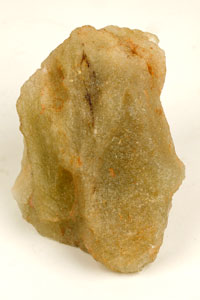 |
Libyan Desert Glass. Tektites are a mixture of earth rocks mixed with a sprinkling of meteorite material from an immense explosive event that occurred when a very large rocky meteorite vaporized before impacting the earth. The resulting mixture forms glass-like mixture. The color is usually black but it can also be green or yellow depending on the amount of silica present. This huge, over-3-pound, 4.75 x 4 x 3 inch large specimen of Libyan Desert Glass is unusually pristine from being buried in the Sahara sand (near the border of Libya and Egypt). It is medium green in color with a smooth glossy bottom, having just beneath the surface small white spheres of Cristobalite, which is a form of quartz that only forms at very high temperatures above 1470 degrees centigrade. The presence of Cristobalite proves the meteorite impact origin of Libyan Desert Glass, as the only other way it could form in the desert would be from a volcano and there was never a volcano anywhere near this area. There are some regmaglypts as well as small holes in the surface and the specimen stands on its own. This is one of the largest specimens of Libyan Desert Glass ever auctioned and is especially valuable. A small 125-gram specimen sold for over $6,000 in a New York auction in October, 2007.
Add $20 to domestic shipping.
Estimated Value $1,800 - 2,500.
View details and enlarged photo
| Realized
$1,980 |
Lot 1673 |
 |
Meteorite From The Biggest Meteor Strike Since 1907. At 9:20 A.M. on the morning of February 15, 2013 a large 8-10 ton 50 foot long meteor exploded 10-15 miles above the ancient city of Chelyabinsk, Russia with the force of over 500,000 tons of TNT 10 times the force of the atomic bomb that destroyed Hiroshima in 1945. More than 1,500 people were injured from flying glass and debris from the resulting shock wave. This was the largest meteor event in the last 100 years since a large meteor exploded over a remote area of Siberia in 1907. The official name of this meteorite is Chelyabinsk, where most of the injuries occurred, but most of the meteorite specimens were found on the frozen surface of Chebarkul Lake, which is a frozen fresh water lake that is located directly in the meteorite strewnfield about 50 miles west of the city of Chelyabinsk. It is both on this snow-covered lake and the surrounding forest where most of the pieces of the stony chondrite LL5 SR4 meteorite were recovered. Because of the immense explosion and ablation through Earth's atmosphere, most of the meteor was either burned up or blasted into a fine powder. More than 95% of the recovered meteorites are extremely small, less than 3 grams in weight.
This beautiful fresh 31 x 28 mm complete specimen weighs 24.4 grams which is much larger than the vast majority recovered. It has a fresh black fusion crust covering more than 75% of the meteorite with the bottom side offering a window inside of the meteorite showing its light gray matrix mixed with specks of iron and rust orange chondrules. This stony chondrite is designated as LL5 SR4 meaning that it is of low iron even for a stony meteorite with the total iron content to be about 10 percent. It is not possible to obtain a fresher meteorite and it is very valuable for study in that there has been no contamination with Earth rocks and erosion. Comes housed in a 8 x 6 inch Riker mount with a photo of the explosion.
Add $20 for domestic shipping.
Estimated Value $1,250 - 2,000.
View details and enlarged photo
| Unsold |
Lot 1674 |
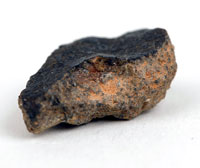 |
Martian Meteorite NWA 7397. Meteorites from the planet Mars are so rare that usually only small fragments are available for sale. These rare meteorites have been identified as being from Mars because of their chemical analysis, age and lack of attracting a magnet. They have to be from a planet and not an asteroid because they are not magnetic like the rest of the stony meteorites. NWA 7397 was a single 2.13 kg meteorite found near Smara, Morocco in 2012 and was designated as a rare Basaltic Martian Shergotite that was ejected from the large impact that occurred on Mars millions of years ago. This large 20 x 10mm fragment weighs a hefty 2.67 grams and has more than 40% of its original dark brown fusion crust that formed when its surface was burning during its entry into the Earth's atmosphere. It is much larger than the usual grain sized specimens and can be easily studied for detail and held in one's hand for a unique Martian experience. It comes with a signed authenticity card signed by meteorite man Rubin Garcia. For protection it is contained within a 8.5" x 6" Riker mount.
Add $20 for domestic shipping.
Estimated Value $1,200 - 2,000.
View details and enlarged photo
| Realized
$3,060 |
Lot 1675 |
 |
Large Stony Meteorite. Most stony meteorites are small because the larger stony meteorites usually break apart or explode before they contact the earth. This large 5X3.25X2 inch 3.25 pound complete stony is one of the exceptions. It is designated as an unclassified NWA meteorite meaning that it was found by Berbers in the Sahara desert of Morocco and has not been sent into the meteorite institute for classification. It probably is an ordinary chondrite which means that it consists of round silicate grains that formed at the very beginning of the solar system 4.55 billion years ago from molten globs of accreted material that stuck together to form the asteroid from which this meteorite was blasted off when two asteroids collided millions of years ago. All stony meteorites contain iron and are designated as either low or high iron and are quite heavy for their size. This meteorite is completely original just as found in the desert with nearly complete dark brown fusion crust on the bottom side that was buried in sand. The top part of the meteorite that was exposed to the elements has most of the fusion crust intact with just slight weathering. Fusion crust is the thin dark brown layer that forms from the high heat when the meteorite passes through the earth's atmosphere. This museum quality stony meteorite is one of the top 2% of recovered meteorites and comes with a plastic stand for display.
Add $20 for domestic shipping.
Estimated Value $1,000 - 1,500.
View details and enlarged photo
| Unsold |
Lot 1676 |
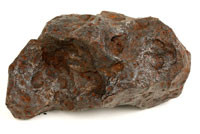 |
Meteorite Campo Del Cielo 8.5 POUNDS. Most iron-nickel meteorites are just hunks of metal without an interesting shape. This large 6.25 x 3.75 x 3.5 inch 8.5 pound new Campo del Cielo iron-nickel meteorite is the exception, having an aesthetic shape with its iron-nickel surface covered with desirable regmaglypts (thumbprints) including a very large 2 x 2 inch regmaglypt. Regmaglypts formed when the meteor passed through Earth's atmosphere and the troilite in the meteorite melted. First recorded by the Spanish in 1576, the huge fall of Campo del Cielo (Valley of the Sky) iron-nickel meteorites occurred thousands of years before. The best quality Campos such as this choice specimen were recovered high in the mountains where their surface was not rusted away by ground water. The Campo field has been mostly explored and the price of quality Campos is rising dramatically as new specimens are becoming very difficult to locate and demand for meteorites has been steadily increasing. A smaller five pound Campo del Cielo meteorite sold for over $3000 in a New York auction in September, 2007.
Add $20 for domestic shipping.
Estimated Value $1,000 - 1,500.
View details and enlarged photo
| Realized
$930 |
Lot 1677 |
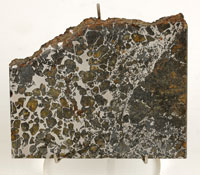 |
Meteorite Seymchan Pallasite. Two meteorites weighing 323 Kg were found in 1967 in Seymchan, a Magadan district in far eastern Russia. Originally, Seymchan was believed to be just an iron-nickel meteorite but just recently olivine crystals were found in parts of some of the Seymchan meteorites which makes it a far rarer Pallasite. Pallasites are literally gemstones from outer space containing olivine crystals mixed in with the iron-nickel matrix. This large 4.5 x 3.5 inch 238.3 gram slice has more than 50% olivine crystals and silicate inclusions in its iron-nickel matrix and has been polished to reveal this interesting interior including two greenish translucent olivine crystals. The olivine cryatals in Seymchan are smaller in diameter than in most Pallasites. Seymchan slices are remarkably stable. Comes with a 5 inch high illusion stand for presentation.
Add $20 for domestic shipping.
Estimated Value $850 - 1,300.
View details and enlarged photo
| Unsold |
Lot 1678 |
 |
Meteorite Campo del Cielo Etched Half. The famous iron-nickel meteorite Campo del Cielo fell to the earth over 4,000 years ago in mountainous region of Gran Chaco, Argentina, 500 miles north-northwest of Buenos Aries, in one of the largest and undoubtedly most dramatic falls in the last 10,000 years. Meteorites from this fall were scattered over hundreds of square miles of inaccessible terrain. This heavy 5 x 3 x 2.75 inch meteorite cut in half weighs 4.5 pounds and has been polished and etched on two sides to show its Widmanstatten pattern which results from two alloys of Nickel in the meteorite etching at different rates. There are no iron-nickel rocks on Earth that exibit a Widmanstatten pattern because the parent asteroid where these iron-nickel meteorites originate was destroyed by impact with another large asteroid and the new melted iron-nickel core had to cool at the very slow rate of a couple of degrees per million years to allow enough time for the nickel alloys Kamacite (the light bands which are low in nickel) and Taenite (the dark bands which are high in nickel) to separate. This spectacular half meteorite has the original surface with regmaglypts and fusion crust all around except for two sides that have been beautifully etched to show the coarse octahedrite pattern of this Type 1A iron-nickel meteorite.
Add $20 for domestic shipping.
Estimated Value $850 - 1,000.
View details and enlarged photo
| Unsold |
Lot 1679 |
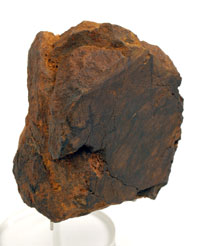 |
Meteorite Fossilized EL3. Enstatite chondrite meteorites (categorized as a EL3) are scarce stony meteorites which are different from ordinary chondrites. Their pyroxene contains almost no iron, being made up of nearly pure enstatite (magnesium silicate). Al-Haggounia 001 is considered to be a fossilized meteorite as it fell in the Saharan region of Morocco near Al-Haggounia over 23,000 years ago, well before the Sahara even became a desert. These meteorites were dug out of the ground and have a rusty brown outer surface due to being altered over thousands of years. This large 4.5 x 3.75 x 2.5 inch 2.5 pound end cut is much larger and in better condition than most specimens that have been recovered. The cut face has several shades of brown and many long darker metallic shock lines attesting to the violent impact that ejected them from their parent asteroid millions of years ago. There is even some dark fusion crust remaining on the rest of the meteorite from its fiery entry into the Earth's atmosphere. Worth much more than a common stony meteorite. Comes with a 5 inch illusion stand for display.
Add $20 for domestic shipping.
Estimated Value $800 - 1,200.
View details and enlarged photo
| Unsold |
Lot 1680 |
 |
Four Emerald Crystals in Quartz Matrix. Emeralds have been value since ancient times for their beauty and rarity. This lovely specimen has four pentagon shaped Emerald crystals in their natural 5.5 x 4.5 inch quartz matrix as found many years ago in Youn Nan Province, China. Acquired from an old collection, the beautiful green Emerald crystals are 3.25, 2.75, 2.25 and 2 inches in length. This valuable crystal comes on a custom 4.5 inch wooden stand for display.
Add $20 for domestic shipping.
Estimated Value $950 - 1,400.
View details and enlarged photo
| Realized
$528 |
Lot 1681 |
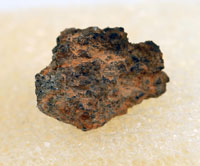 |
Martian Mini-Meteorite Complete And Uncut. Meteorites from the planet Mars are so rare that only small fragments are available for sale. These rare meteorites have been identified as being from Mars because of their chemical analysis and age. They are younger than most of the meteorites from the asteroid belt that were formed at the same time as the solar system, 4.5 billion Years Ago. It is now believed that most, if not all, of the Martian meteorites originated from one gigantic meteorite impact that left the more recent Zumba crater in the Daedalia Planum on Mars. In 2011, in the Sahara desert of Morocco, near the river Oued Touflit, a number of small individual meteorites with a total weight of about 8 Kg were found and submitted for analysis. This Martian meteorite (named NWA 6963) was found to be a rare achondrite basaltic (volcanic) Martian Shergotite with abundant maskelynite and shock melt veins, and represents one of the freshest Martian Shergotites found. This specimen is 12 x 9 mm, weighing 0.70 grams and has more than 30 percent of its original dark brown fusion crust from burning in the Earth's atmosphere. The reason that only small individual meteorites were found is because the original larger meteorite broke up high in the Earth's atmosphere and the small pieces continued to burn as they hit the Earth. This is a rare opportunity to acquire a complete meteorite that you can hold in your hand from the planet Mars. Preserved in a 6 x 5 inch Riker mount.
Add $15 for domestic shipping.
Estimated Value $500 - 700.
View details and enlarged photo
| Realized
$324 |
Lot 1682 |
 |
Meteorite From Meteor Crater. This good sized 2.5 x 2.5 x 1.5 inch, over 1 pound (514 grams) Canyon Diablo iron-nickel meteorite is a palm sized specimen of one of the most sought after iron meteorites by collectors. Most currently available Canyon Diablo meteorites are just a few grams in weight. Any sizeable specimens are hard to come by as the area around Meteor Crater near Winslow, Arizona has been closed for years. The nearly one mile in diameter crater was created over 50,000 years ago when a 50 foot in diameter meteor exploded high over the Arizona desert. This popular meteorite possesses a typical gunmetal color and several large partial distinctive regmaglypts (thumbprints). Since no specimens are available from the source at Meteor Crater, the only way to acquire a specimen is when specimens are made available from collections. Comes with a magnetic stand for display.
Add $15 for domestic shipping.
Estimated Value $500 - 700.
View details and enlarged photo
| Realized
$300 |
Lot 1683 |
 |
Pallasovka Pallasite Meteorite. Pallasites are the rarest of the iron-nickel meteorites and are known as gemstones from space as they contain olivine crystals, the gem form known as Peridot within the matrix of the iron-nickel. Pallasovka is one of the scarcer Pallasites with only a single meteorite weighing 198 Kg. It was found about 18.5 Km from the famous town of Pallasovka, which was named after Peter Pallas. Pallas found the Krasnojarsk meteorite in 1749 and realized it was different from other iron-nickel meteorites, containing crystals of olivine, and named it a Pallasite. So that makes the Pallosovka meteorite a Pallasite named after the town near where it was found, which was named after the founder of the very first Pallasite. This 62.5 gram polished slice is 2.75 x 2.75 inches with more than 75% of its iron- nickel surface covered with olivine crystal, with a few of them being translucent. Presented in a 5 x 4 inch Ryker box.
Add $15 for domestic shipping.
Estimated Value $450 - 650.
View details and enlarged photo
| Realized
$348 |
Lot 1684 |
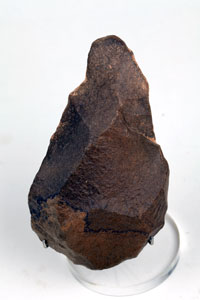 |
Hand Axe From Homo Heidelbergensis. This extremely large 6 inch x 3.25 inch hand axe is from the Achelean and is between 120,000 to 300,000 years old. It was sculpted out of stone by an archaic Homo species such as Homo heidelbergensis that may have been one of the direct ancestors of Homo sapiens. This large heavy hand axe probably had multiple uses, from cutting meat to use as a weapon. This 6 inch medium brown hand axe was chiseled by hand by an early homo species to form a sharp point, sharp edges and flat side that fits perfectly in the palm of the hand. These hand axes may have been made over a period of thousands of years and were found in the Western Sahara Desert. This is a rare and interesting early human artifact that shows that the early human hand was similar in size and shape to our own. Comes with a 5 inch illusion stand for display.
Add $15 for domestic shipping.
Estimated Value $400 - 600.
View details and enlarged photo
| Realized
$480 |
Lot 1685 |
 |
Nantan Iron-Nickel Meteorite. The Nantan Iron-Nickel meteorite is one of the earliest meteorites that was an observed fall. It was recorded that it fell May 11, 1516 in the Nantan County of Guangxi, Province of China. The meteorite fall was described as "stars falling from the northeast direction, five to six fold long, waving like snakes and dragons." It is a seldom-offered meteorite composed of 92.35% iron and 6.96% nickel. This fairly large 4 x 4 x 2 inch, 4.75 pound meteorite has the usual compact shape and dark brown color that is common with Nantan meteorites, with shallow regmaglypts and one crack on its surface. It is displayed on a 5 inch illusion stand.
Add $15 for domestic shipping.
Estimated Value $400 - 550.
View details and enlarged photo
| Realized
$250 |
Lot 1686 |
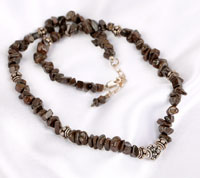 |
Meteorite Jewelry Necklace. Made from the stony meteorite NWA 869, this 22.5 inch long necklace is made with irregular sections of the stony meteorite with eight .25 inch diameter sterling silver Bali style beads plus one oval sterling silver Bali bead with a 2.75 inch sterling silver extension chain. At 3.57 billion years old, these meteorite beads are older than any rocks or gemstones on Earth and have small pieces of chondrites in the medium brown matrix that authenticate them as being from a meteorite, since no rocks on Earth today have chondrites in them. The chondrites that were present when the Earth formed have been lost to volcanic activity over the last 3.57 billion years. The beads are magnetic because even stony meteorites have up to 20% iron flakes in them. Most meteorites are too rare and valuable to make jewelry out of, but fortunately, enough of North West Africa 869 was found in the Sahara desert to make such a rare and unique gift available. Comes with a certificate of authenticity.
Add $15 for domestic shipping.
Estimated Value $400 - 550.
View details and enlarged photo
| Realized
$408 |
Lot 1687 |
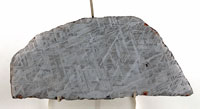 |
Meteortie Muonionalusta Slice. Muonionalusta is an iron-nickel meteorite that was found in Norrbotten, Sweden in 1906 and since then additional meteorites have been found in one of the largest strewnfields on earth at 30 x10 kilometers. Muonionalusta is classified as a fine octahedrite and has one of the most beautiful Widmanstatten patterns when it is etched. Widmanstatten patterns form when the two alloys of nickel Kamacite and Taenite separate in the iron core of the large asteroid that was destroyed by collision with another large asteroid in the asteroid belt billions of years ago. This separation and pattern form only when the iron core cools at a rate of only a few degrees per million years and is not found on any iron-nickel stones on earth. This large 6.25 x 2.75 inch 160 gram section has been etched on both sides and displays one of the most beautiful Widmanstatten pattern found on any iron-nickel meteorite and is very similar to the pattern found on the Gibeon meteorite which is probably from the same parent asteroid body.
Add $15 for domestic shipping.
Estimated Value $350 - 450.
View details and enlarged photo
| Realized
$264 |
Lot 1688 |
 |
Gold Meteorite Bracelet. This rare and unusual rolled gold bracelet has nine rectangular 10 x 3mm meteorite beads embedded in a thick rolled 14 karat gold bracelet. Rolled gold is about 100 times as thick as gold plate and lasts a long time. Each of the rectangular beads has been carefully cut from an ordinary chondrite stony meteorite NWA 869 that formed at the origin of the solar system 3.57 billion years ago. Chondrites are the very first material that formed out of the hot solar gases that formed the solar system. They are studied by scientists to learn what the original building blocks of the solar system were composed of. No rocks on earth have this chondrite structure because it was destroyed millions of years ago through volcanism. Chondrites of all shapes and sizes are visible in each of the nine rectangular meteorite beads. This bracelet is both beautiful and scientifically interesting. This is a very rare opportunity to buy meteorite jewelry, as most meteorites are worth much more as intact meteorites. Comes with a certificate of authenticity.
Add $15 for domestic shipping.
Estimated Value $350 - 550.
View details and enlarged photo
| Realized
$630 |
Lot 1689 |
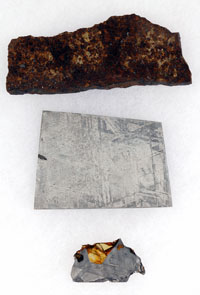 |
Meteorite Three Piece Type Set. There are three major types of meteorites, stony, stony-iron and iron-nickel. This lot contains a sizeable polished section from each type of meteorite. The stony meteorite which comes from the surface rocks of its parent asteroid is a 65 x 25 mm, 22 gram complete section of NWA 4528, an ordinary chondrite from North West Africa. This meteorite has a dark brown surface with roundish chondrites and flecks of iron distributed throughout. The stony-iron specimen is a Fukang Pallasite from China. Pallasites are literally gemstones from space with translucent olive crystal interspersed in an iron-nickel matrix. This lovely 26 x 14mm, 3 gram section has been polished to show a large beautiful translucent yellow-green olivine crystal. The third meteorite section is from an iron-nickel meteorite Gibeon from Namimbia. It is 46 x 35 mm, weighing 20 grams, and has been polished and etched, revealing the distinctive fine octohedrite Widmanstatten pattern. This collection is housed in a 8 x 6 inch Riker Mount.
Add $15 for domestic shipping.
Estimated Value $325 - 450.
View details and enlarged photo
| Realized
$238 |
|
|